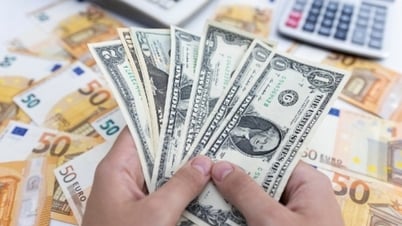At the end of the trading session on January 8, oil prices unexpectedly fell more than 1%, giving up the gains from the beginning of the session. A stronger USD and a sharp increase in US fuel inventories put pressure on prices, reversing previous gains due to tightening supplies from Russia and members of the Organization of the Petroleum Exporting Countries (OPEC). Domestically, gasoline prices are forecast to continue to increase this afternoon.
 |
| At the end of the trading session on January 8, oil prices unexpectedly fell more than 1%, giving up the increase from the beginning of the session. Domestically, gasoline prices are forecast to continue to increase this afternoon. (Photo: Ngoc Ha) |
Brent crude fell 89 cents, or 1.16 percent, to $76.23 a barrel. U.S. West Texas Intermediate crude fell 93 cents, or 1.25 percent, to $73.32 a barrel.
Explaining the plunge in oil prices, Andrew Lipow, president of Lipow Oil Associates, said: The oil market has been weighed down by a significant increase in U.S. gasoline and diesel inventories over the past few weeks. Fuel inventories have increased as refineries continue to increase production.
Gasoline inventories rose 6.3 million barrels to 237.7 million barrels in the week ended January 3, more than four times analysts' expectations for a 1.5 million barrel increase, according to data released by the US Energy Information Administration. Distillate inventories also rose 6.1 million barrels to 128.9 million barrels, more than 10 times analysts' expectations for a 600,000 barrel increase.
In contrast to the increase in gasoline and distillate inventories, US crude oil inventories continued to record a weekly decline with a decrease of 959,000 barrels to 414.6 million barrels, down more than 5 times the analysts' expectation of a decrease of 184,000 barrels.
Also weighing on oil prices is a stronger US dollar, which makes oil more expensive for holders of other currencies.
To limit losses, OPEC oil output fell in December 2024 after two months of increases as maintenance activities in the United Arab Emirates offset output increases in Nigeria and some other countries in the group.
Meanwhile, in Russia, Bloomberg quoted a source from the country's Ministry of Energy as saying that in the last month of 2024, average oil production reached 8.971 million barrels per day, lower than the target.
Analysts expect average oil prices to fall this year compared to last, partly due to increased production from non-OPEC countries.
BMI, part of Fitch Group, said it maintained its forecast for Brent crude oil prices to average $76 a barrel in 2025, down from an average of $80 a barrel in 2024.
Domestic retail prices of gasoline on January 9 are as follows:
E5 RON 92 gasoline is not more than 20,057 VND/liter. RON 95-III gasoline is not more than 20,746 VND/liter. Diesel oil not more than 18,755 VND/liter. Kerosene not more than 18,834 VND/liter. Fuel oil not exceeding 16,099 VND/kg. |
The above domestic retail prices of gasoline and oil will be adjusted by the Ministry of Finance and the Ministry of Industry and Trade in the price management session this afternoon (January 9). Since world gasoline and oil prices continued to increase last week, it is likely that domestic gasoline and oil prices will also continue to increase.
In the most recent price adjustment, the price of E5 RON 92 gasoline increased by VND240/liter, RON 95-III gasoline increased by VND199/liter, diesel increased by VND125/liter, kerosene increased by VND126/liter, and fuel oil increased by VND129/kg.
Source: https://baoquocte.vn/gia-xang-dau-hom-nay-91-the-gioi-quay-xe-giam-hon-1-trong-nuoc-nhieu-kha-nang-giu-da-tang-300223.html


![[Photo] Prime Minister Pham Minh Chinh attends the groundbreaking ceremony of Trump International Hung Yen Project](https://vphoto.vietnam.vn/thumb/1200x675/vietnam/resource/IMAGE/2025/5/21/ca84b87a74da4cddb2992a86966284cf)

![[Photo] General Secretary To Lam works with the Central Inspection Commission](https://vphoto.vietnam.vn/thumb/1200x675/vietnam/resource/IMAGE/2025/5/22/54820e91fd124c4cb691961718c4ee5d)


![[Photo] Determining the pairs in the team semi-finals of the National Table Tennis Championship of Nhan Dan Newspaper](https://vphoto.vietnam.vn/thumb/1200x675/vietnam/resource/IMAGE/2025/5/21/eacbf7ae6a59497e9ae5da8e63d227bf)


















![[Photo] Prime Minister Pham Minh Chinh chairs the Government's special meeting on law-making in May](https://vphoto.vietnam.vn/thumb/1200x675/vietnam/resource/IMAGE/2025/5/22/1c880aae96fd4e0894abc47a46fe19ba)





































































Comment (0)